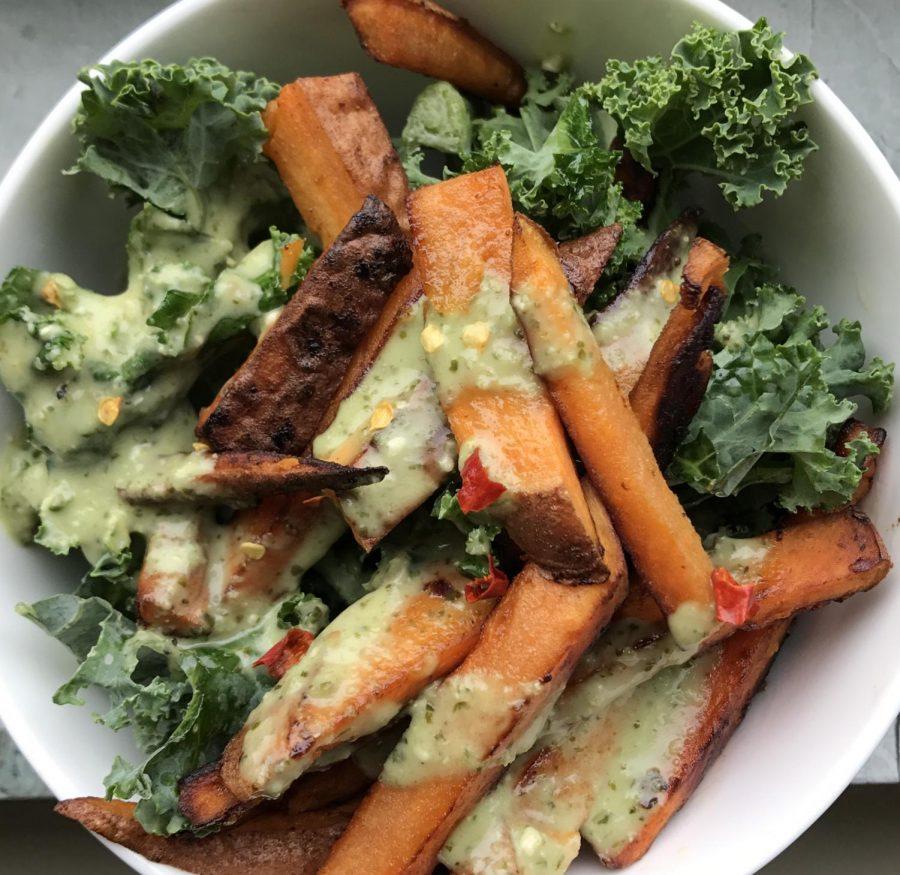Consumed by Health Trends
A healthy kale and sweet potato bowl.
January 30, 2018
In a world of manic and obscure wellness practices to make the most of our vivacious youth past the unapologetic wrath of aging, health trends have behaved as the haphazard answer for our worries. What used to be a simple regiment of finishing the gross bits of vegetables from dinner, now health seems to be something left for the trendy, leisurely and seemingly well-off.
With each year and season, a long list of the next hottest “it” food items are compiled and spread like wildfire. Starting as early as November 2017, health and wellness websites, such as Sporteluxe, began to predict trends for the upcoming year. Were there any similarities between the multiple lists published? Surprisingly, yes. Today and Sporteluxe both featured upcycled food, inventive meat substitutes and superfood powders as key trends to watch out for and to participate in. With overlapping predictions, there seemed to be a significant method to the madness in the healthy lifestyles’ world.
When kale was still the rising star of health food in 2017, the Chicago Tribune began to question how food trends came to be. Specifically in regards to how major food distributor US Foods looks into introducing the next health food trends to restaurants, the main characteristics seemed to be: easy to cook, healthy, useful in multiple dishes and, of course, delicious.
As a busy, lacking-of-self-care student, those characteristics seem ideal. A food that would be tasty, easy to cook, healthy and multi-purposeful in many dishes and that is deemed as a trendy health food almost seems too good to be true. Cauliflower, for instance, makes the cut as scrumptious cauliflower rice, cauliflower crust, even a vegan chicken substitute that are all easy to make. But with other health food trends such as pricy superfood powder moringa that are more obscure and marketed as specialty items rather than cook-at-home projects, health seems to have evolved into something more of an exclusive club.
CAS sophomore Jia Liu understands people’s interests in taking care of their physical health, however she is critical of health food straying from its simplistic roots and entering a new elitist world.
“As people of better economic status have the motivation and support for such a lifestyle, there are also others who lack the financial ability to maintain this lifestyle with the health food options that are existent today,” Liu said.
Steinhardt freshman Julia Braverman shares the same sentiment as Liu and considers health food trends to be problematic due to the judgement and negativity that comes with blindly following a health trend.
“It’s not even about what we are consuming — it is about how highly we think of ourselves,” Braverman said. “A lot of people think that by conforming to a health craze it represents good values and characteristics in people — willpower, dedication and self-care.”
Similarly, CAS sophomore Laila Petra finds that the whole health food trend is fueled with negativity rather than a positive trend to better people’s health.
“Looking at the vegan trend, for example, there seems to be a judgemental culture surrounding being vegan and eating clean in general,” Petra said. “There seems to be a major social media hype surrounding it as well, but nothing else that would provide substantial evidence of it being effective.”
All students seem to agree that rather than consuming health food, we’ve become consumed by health food trends. A prediction for a 2018 health food trend? Share your fruits and vegetables and take health into your own hands through self-love beyond consuming some gross green powder for the health of it.
Email Liv Chai at [email protected].



























































































































































